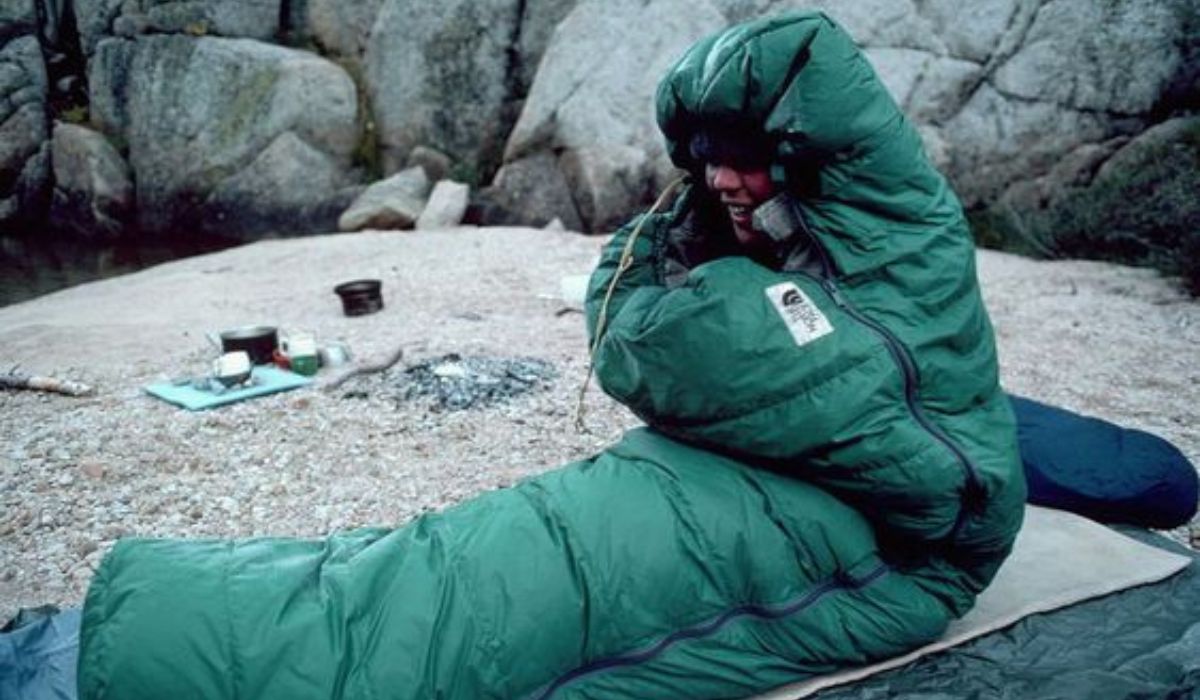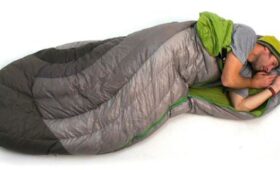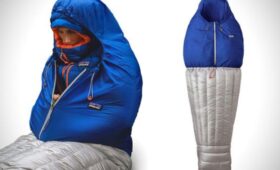
Picture this: it’s a calm, starry night at your favorite camping spot. You’re nestled in your cozy sleeping bag, feeling the gentle sway of the cool breeze as you drift off to sleep. The right sleeping bag can make all the difference in the world, ensuring you wake up refreshed and ready to tackle the adventures that lie ahead.
But with so many options out there, how do you choose the perfect sleeping bag for your camping needs? Whether you’re a seasoned adventurer or a newbie to the camping scene, this guide will provide you with essential tips on selecting the ideal sleeping bag.
Key Takeaways:
- Consider the temperature rating of the sleeping bag, choosing one slightly lower than the lowest temperatures you expect to encounter.
- Think about the type of insulation, whether down or synthetic, based on your priorities of weight or water resistance.
- Take into account the size and shape of the sleeping bag, opting for a mummy bag for colder temperatures and a rectangular bag for more room to move.
- Look for additional features like adjustment features, stash pockets, and pad compatibility that suit your specific needs and preferences.
- By evaluating these factors and prioritizing your needs, you can select a sleeping bag that ensures a comfortable night’s sleep during your camping adventures.
Understanding Sleeping Bag Temperature Ratings
A sleeping bag’s temperature rating is an essential factor to consider when choosing the right sleeping bag for your camping adventures. The temperature rating indicates the lowest temperature at which the bag can keep an average sleeper warm. It’s crucial to select a sleeping bag with a temperature rating lower than the lowest temperature you expect to encounter during your camping trips.
However, it’s important to note that temperature ratings alone do not guarantee warmth. Various variables can affect your comfort, such as the R-value of your sleeping pad and the clothing you wear inside the bag. To ensure optimal warmth, it’s vital to consider the sleep system data, which takes into account the interaction between your sleeping bag, sleeping pad, and clothing.
The sleep system data provides a more comprehensive understanding of how your sleeping bag will perform in different temperature conditions. It allows you to make informed decisions by considering the combined impact of your gear on your overall insulation. By analyzing the sleep system data, you can optimize your comfort and effectively tackle unexpected drops in temperature.
It’s worth mentioning that a high-quality sleeping pad with a good R-value can greatly enhance the insulation provided by your sleeping bag. Additionally, layering your clothing appropriately can add extra warmth, allowing you to counter colder temperatures effectively.
Remember, sleeping bag temperature ratings serve as a helpful guideline, but they should not be the sole determining factor. Take into consideration the sleep system data, the R-value of your sleeping pad, and your clothing choices to ensure a comfortable night’s sleep, regardless of the outside temperature.
Understanding Sleeping Bag Insulation Types
When it comes to choosing the right sleeping bag, understanding the different insulation types is essential. Two main options dominate the market: down and synthetic insulation. Each type has its own unique characteristics, catering to different camping needs.
Down Insulation
Down insulation is derived from the soft and fluffy feathers found beneath the outer feathers of ducks and geese. It is renowned for its exceptional warmth-to-weight ratio, which means it provides excellent insulation without adding excessive weight to your backpack. It is also highly compressible, making it ideal for backpackers and those looking for a lightweight sleeping bag option. Furthermore, down insulation offers exceptional breathability, keeping you comfortable in a variety of temperatures.
Synthetic Insulation
Synthetic insulation, on the other hand, is made from man-made materials such as polyester or nylon fibers. It is a more affordable option compared to down insulation and performs better when wet. Unlike down, synthetic insulation retains its insulating properties even when damp or exposed to moisture, making it an excellent choice for camping in damp or humid climates. Synthetic insulation is also easier to clean and maintain, as it is machine washable.
When deciding between down and synthetic insulation, consider your camping preferences and priorities. If you prioritize weight and compressibility, down insulation may be the preferred choice. On the other hand, if you anticipate camping in wet conditions or are looking for a more budget-friendly option, synthetic insulation may be the better fit for you.
Sizing and Shape Options for Sleeping Bags
The size and shape of a sleeping bag are crucial factors to consider when choosing one. The right size and shape can significantly impact your comfort during outdoor adventures. Let’s explore the two main options: mummy sleeping bags and rectangular sleeping bags.
Mummy Sleeping Bags
Mummy sleeping bags are designed to contour closely to the body, reducing excess fabric and maximizing warmth. This shape helps retain body heat more efficiently, making it ideal for backpacking and colder temperatures. The tapered design around the legs and feet minimizes extra space, providing a snug and cozy fit. If you prioritize warmth and insulation, a mummy sleeping bag is an excellent choice.
Rectangular Sleeping Bags
On the other hand, rectangular sleeping bags offer a more spacious and roomy design. They provide more freedom of movement, allowing you to stretch out and move comfortably inside the bag. Rectangular sleeping bags are well-suited for summer camping trips, as they provide excellent ventilation and breathability. They are also popular among individuals who prefer a less restrictive sleeping experience.
When selecting a sleeping bag size, take your height into consideration. Some sleeping bags are available in multiple lengths to accommodate different user heights. If you enjoy a snug fit and want to maximize warmth, choose a smaller size. However, if you prefer a bit more room to stretch and move around, opt for a larger size.
Remember, whether you choose a mummy or rectangularsleeping bag, comfort is subjective. Consider your camping conditions, temperature requirements, and personal preferences when making your decision.
Now that we’ve explored the sizing and shape options for sleeping bags, let’s move on to the next section, where we’ll discuss the key features to consider when choosing a sleeping bag.
Key Features to Consider When Choosing a Sleeping Bag
When selecting a sleeping bag, it’s important to not only focus on the essential factors like temperature ratings and insulation types but also consider the additional features that can greatly enhance your camping experience. These features can provide added convenience, comfort, and versatility to your sleeping bag. Here are some key features to consider:
- Adjustment Features: Look for sleeping bags that offer various adjustment options. This can include adjustable hood and collar drawcords, zippered vents for temperature regulation, and draft tubes or draft collars to prevent cold air from entering.
- Stash Pockets: Having small pockets on the inside or outside of your sleeping bag can be incredibly useful for storing personal items like your phone, keys, or a headlamp. It keeps them close at hand and prevents them from getting lost or tangled during the night.
- Pad Compatibility: Some sleeping bags come with attachment systems or sleeves that allow you to secure the bag to your sleeping pad. This prevents you from sliding off the pad during the night and helps to regulate your body temperature more effectively.
- Hood: A sleeping bag with a hood can provide added warmth and insulation for your head and neck. This is particularly beneficial in colder temperatures or windy conditions.
By considering these sleeping bag extras, you can customize your camping experience to suit your specific needs and preferences. Whether it’s adjusting the airflow, having easy access to your belongings, securing your sleeping bag to your pad, or staying warm and cozy with a hood, these features can greatly enhance your comfort and enjoyment during your camping adventures.
Conclusion
Choosing the perfect sleeping bag is essential for a comfortable camping experience. By considering various factors such as temperature rating, insulation type, size and shape, and additional features, you can find a sleeping bag that meets your specific needs.
When it comes to temperature rating, be sure to select a bag that is rated slightly lower than the lowest temperatures you expect to encounter. This will ensure that you stay warm and cozy throughout the night.
Insulation type is another crucial consideration. Down insulation offers superior warmth-to-weight ratio and compressibility, while synthetic insulation performs better in wet conditions. Depending on your priorities, you can choose the one that suits your camping style and preferences.
Size and shape also play a significant role in comfort. Mummy sleeping bags provide a snug fit and are ideal for backpacking and colder temperatures, while rectangular sleeping bags offer more room to move around and are suitable for summer camping.
Lastly, consider the additional features that enhance your sleeping bag experience. Adjustable features, stash pockets, pad compatibility, and hoods are just a few examples. Tailor these features to your needs and preferences.
Be sure to evaluate the specific climate and conditions of your camping trips, and choose a sleeping bag accordingly. With careful consideration and prioritization, you can select the perfect sleeping bag that ensures a restful night’s sleep. Happy camping!


